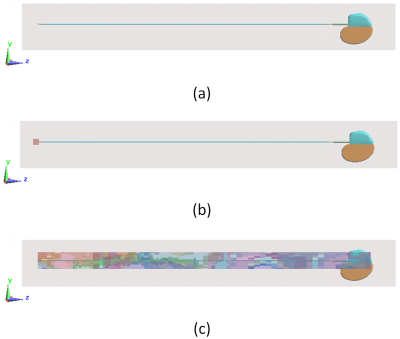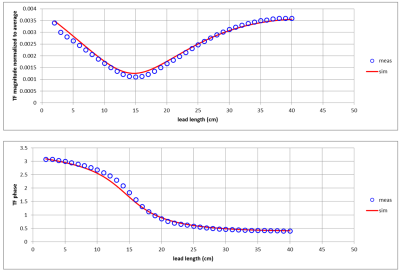1469
Implantable Lead MRI RF Heating in-vivo Transfer Function Modeling to Determine Suitable Test Medium1Abbott Laboratories, Sylmar, CA, United States
Synopsis
This abstract presents a novel technique to determine the suitable tissue simulating medium (TSM) conductivity for MRI lead electrode RF heating transfer function (TF) determination. The proposed method utilizes validated numerical lead model in conjunction with tissue models extracted along lead trajectories in anatomical models to produce in-vivo transfer function models. When combined with in-vivo incident electric fields, the power deposition or temperature rise predicted by the in-vitro and in-vivo TFs can be compared to assess the suitability and conservativeness of the selected TSM conductivity.
Introduction
To investigate the active implantable medical device (AIMD) lead electrode RF heating during MRI scan, the transfer function (TF) method1 is often utilized to predict the in-vivo temperature rise (ΔT) or power deposition (PD) around an electrode via in-vitro measurement with device submerged in homogeneous tissue simulating medium (TSM). To determine a suitable TSM electrical conductivity value for a lead, study2 was conducted using numerical simulation of straight wire model. In this abstract, a test method to determine suitable TSM using numerical modeling of realistic implantable device and body tissue models is proposed.Methods
In the proposed method, a TSM conductivity is first selected, the in-vitro TF in homogeneous TSM is then determined experimentally and numerically. If the measured and simulated in-vitro TFs agrees in shape and scaling within a pre-defined uncertainty bound, the simulation model is considered validated. Next, the validated model is combined with tissue blocks extracted along lead trajectories from human body models to generate in-vivo TFs. Using both the in-vitro (homogeneous TSM) and in-vivo (body tissues) TFs, the corresponding ΔT or PD can be determined by combing the TFs with incident tangential electric fields (Etan) obtained from RF coil and human body simulations. A comparison of the ΔT or PD values produced by the in-vitro and in-vivo TFs would reveal whether the selected TSM is suitable for RF heating assessment.Results
The proposed method was first applied on a single straight-wire 58 cm long lead model (1 mm insulation thickness, 2.5 mm exposed electrode tip, lead goes in a dielectric header and terminated on a metal can via a 5 Ω resistor). As shown in Figure 1, three TSM cases are considered: a) homogeneous, b) heterogeneous with tip electrode enclosed in a 10x10x10 mm3 cubic volume with conductivity different from the rest of the region, and c) in-vivo tissues extracted along lead trajectories in human models. For the in-vitro TSMs, the relative permittivity value is fixed at 78. Cardiac lead pathways of five anatomical models (Duke, Ella, Billie, Thelonious and Fats) from the Virtual Family3 are considered. Pathways were chosen to cover the left and right generator placements and various vascular access and pacing sites. A total of ten pathways were studied, two (one left, one right) from each body model. The TFs at 64 MHz in homogeneous TSMs, heterogeneous TSMs, and in-vivo tissues (tip in heart muscle 0.67 S/m, tissue properties follow the IT’IS database5) were calculated using SEMCAD-X4. The in-vitro TFs and in-vivo TFs were combined with in-vivo Etans from the five body models. The resultant maximum PD values are shown in Table 1.
Next, a realistic pacer lead model was developed in SEMCAD-X. The lead is 46 cm long, has a helix tip electrode, a ring electrode and helical conductor wires. The rest of the model features (e.g., header, can, wire termination) are similar to the 58 cm straight wire model. The tip electrode RF heating TF of this lead model was measured experimentally and calculated numerically. The shapes of the TF magnitude and phase are shown to be the same in Figure 2. The simulated and measured TF magnitude scaling was found to lie within a pre-determined overall combined uncertainty of 12%. The validated lead model was applied to calculate TFs in the homogeneous 0.47 S/m TSM, 0.65 S/m TSM and in-vivo tissues of the five body models. The maximum in-vivo power deposition values are shown in Table 2.
Discussion
The straight-wire lead model results show that for a TF in homogeneous TSM, the PD scales with TSM conductivity, this is consistent with finding in previous study2. The PD values produced by the heterogeneous TFs and in-vivo TFs show that the effect coming from the TSM along lead body is non-negligible. This finding is further confirmed by the realistic lead modeling result.Conclusion
To the authors’ best knowledge, the in-vivo transfer function of a realistic cardiac lead was investigated for the first time. In summary, the RF heating transfer function of a lead electrode was found to be influenced by both the tissue medium surrounding the electrode, as well as the tissue medium along the lead body. A suitable TSM conductivity can be numerically determined by calculating and comparing the PD or ΔT predictions of the in-vitro and in-vivo transfer function models for a particular lead design. For the investigated lead design, the 0.47 S/m TSM was found to better represent the in-vivo case than the 0.65 S/m TSM.Acknowledgements
No acknowledgement found.References
[1] Shi Feng, Rui Qiang, Wolfgang Kainz, and Ji Chen, A Technique to Evaluate MRI-Induced Electric Fields at the Ends of Practical Implanted Lead, IEEE TRANSACTIONS ON MICROWAVE THEORY AND TECHNIQUES, VOL. 63, NO. 1, JANUARY 2015
[2] Krishna Kurpad, Jingshen Liu, Paul Stadnik, Jeffrey VonArx, Larry Stotts, Wolfgang Kainz, Ji Chen, MRI RF Safety of Active Implantable Medical Devices (AIMDs): Numerical Study of the Effect of Conductivity of Tissue Simulating Media on Device Model Accuracy
[3] https://www.itis.ethz.ch/virtual-population/virtual-population/overview/
[4] SEMCAD-X, https://www.speag.com/products/semcad
[5] Hasgall PA, Di Gennaro F, Baumgartner C, Neufeld E, Gosselin MC, Payne D, Klingenböck A, Kuster N, “IT’IS Database for thermal and electromagnetic parameters of biological tissues,” Version 3.0, September 01st, 2015, DOI: 10.13099/VIP21000-03-0
Figures



